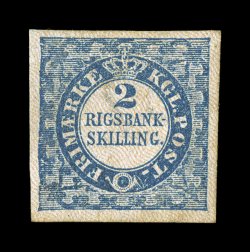

Return To Catalogue - Denmark 1882-1920 - Miscellaneous - Danish West Indies - Bypost (local post)
Curreny 96 Skilling = 1 Rigsbankdaler, after 1875 100 Øre = 1 Krone
Capital Kopenhagen
Note: on my website many of the
pictures can not be seen! They are of course present in the cd's;
contact me if you want to purchase them: evert@klaseboer.com.
2 R.B.S. blue
These stamps have a wavy yellow or brown underprint.
Value of the stamps |
|||
vc = very common c = common * = not so common ** = uncommon |
*** = very uncommon R = rare RR = very rare RRR = extremely rare |
||
| Value | Unused | Used | Remarks |
| 2 R.B.S. | RR | RR | |

The watermark 'Small Crown' seen from the backside of the stamp
Reprints were made in 1886 and 1901 (both no watermark). If anybody posesses information about these reprints, please contact me! A book concerning the reprints exists: 'Reprints of the stamps of Denmark and Danish West Indies' by R.King-Farlow and J.Schmidt-Andersen (I haven't seen this book myself).

(I've been told that this is a reprint)
Forgeries were already described in 'The Stamp Collector's Magazine' in 1864 (1st October, page 155).
Forgery:

The stamps should have a watermark (small crown). The above forgery doesn't have this. The cross on the crown is very clearly visible (in contrast to the genuine stamps). There is no dot behind 'POST' in this forgery, the posthorn is thin. The letters are all different from the genuine stamp and there is no '-' behind 'POST'. This forgery is also described in 'The Spud Papers'. I've been told that this could be a forgery made by the Spiro brothers. Though the cancels are quite different from the usual 'Spiro' products. The only cancels found on these forgeries are numeral cancels with '107', '108' or '112' in the center (non of them were used on the genuine stamps). A blue frameline can sometimes be observed around the stamp.
Other forgeries:
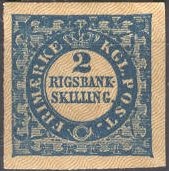
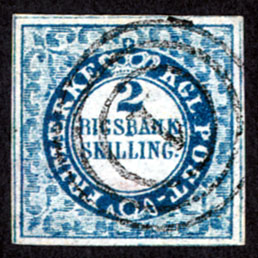

Forgery with the '.' behind 'SKILLING' too far from the nearby
circle. I've only seen this forgery with a numeral '1' cancel.
The '-' behind 'POST' is placed too low.

Most likely a reprint from the book 'DENMARK 2 RIGSBANK-SKILLING
1851-1852' by Trelleborg (1980). Apparently this book contains 48
blue and 200 black rerprints.
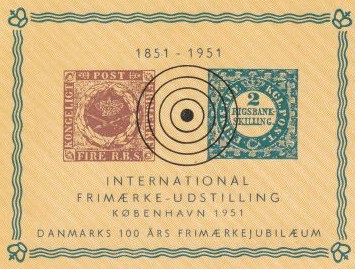
Reprints made in 1951 for the International Frimaerke Udstilling
in Kopenhagen.
2 s (1854) blue FIRE R.B.S. brown (different shades of brown) 4 s brown (different shades of brown) 8 s green 16 s lilac
These stamps have a wavy yellow or brown underprint.
Value of the stamps |
|||
vc = very common c = common * = not so common ** = uncommon |
*** = very uncommon R = rare RR = very rare RRR = extremely rare |
||
| Value | Unused | Used | Remarks |
| Imperforate | |||
| 2 s | *** | ** | |
| 4 R.B.S | RR | * | |
| 4 s | *** | c | Two types: type 1: dots in corners type 2: wavy lines in corners (1857) |
| 8 s | *** | *** | Two types: type 1: dots in corners type 2: wavy lines in corners (1857) |
| 16 s | R | *** | |
| Rouletted | |||
| 4 s | *** | * | 1863 |
| 16 s | RR | RR | 1863 |
A similar stamp with value in 'CENTS' was issued for Danish West Indies.
These stamps should have a watermark (small crown). But caution! There exist also forgeries with watermark! Genuine stamp with watermark:
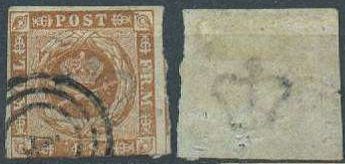
Typical numeral cancels:
More information on numeral cancels can be found in: 'Denmark Numeral Cancels, European Philately 8, J.Barefoot 1983'.

(I've been told that this numeral cancel '3' was used in Lubeck,
Germany)
Other numeral cancels:
2: Hamburg (K.D.O.P.A Hamburg)
11: Cappeln
47: Fredericia
97: Augustenborg
113: Altona
138: Bornhöved
140: Brunsbüttel
146: Wandsbeck
154: Blankenese
176: Ringsted
Rouletted stamps were issued in 1863, some none official perforations also exist, examples:
Reprints of most of these stamps exist (no watermark). If anybody posesses information about these reprints, please contact me! I've been told that the next stamps are reprints:
I've been told that the next two stamps of 16 s are reprints made in 1885:

(Reprints of 1884, reduced sizes)
Forgery of the 2 s stamp:

Two forgeries of the 16 s stamp:
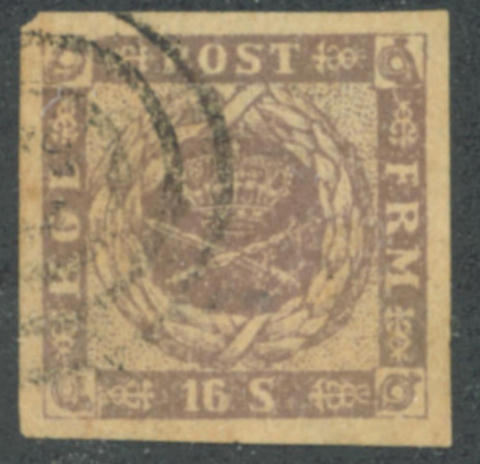

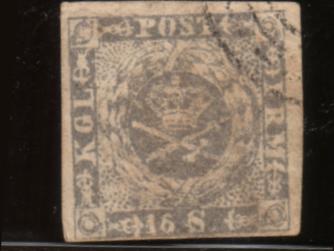
(Forgeries of the 16 s value, note the lettering and the size of
the ornaments at the bottom)
Three forgeries of the 8 s stamp:

A forgery of the 2 s in the wrong colour green
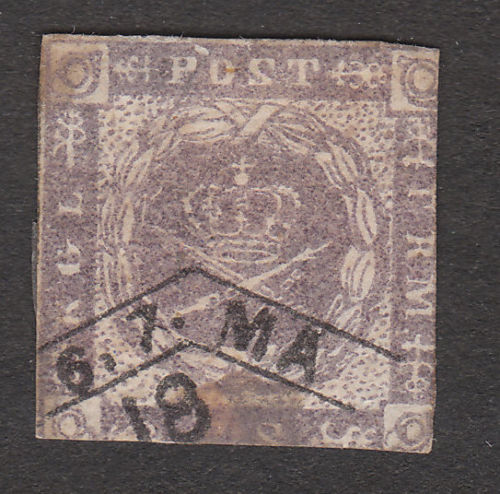

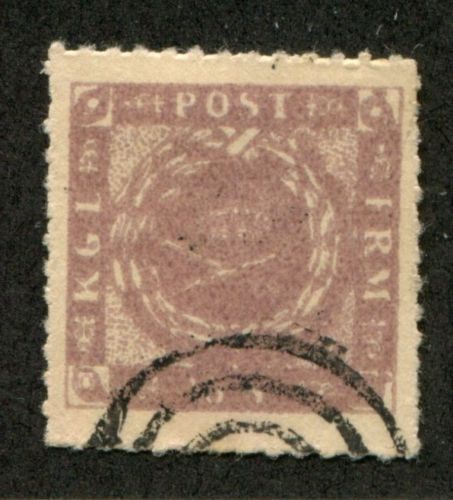
Three other primitive forgeries.

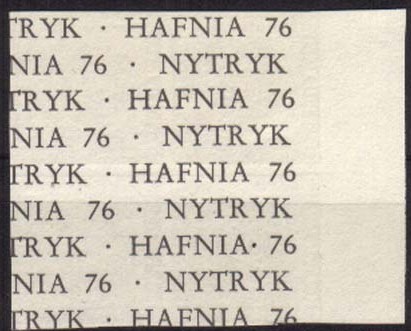
Some reprints 'NYTRYK' made for the 'Hafnia 76' of the 4 s value
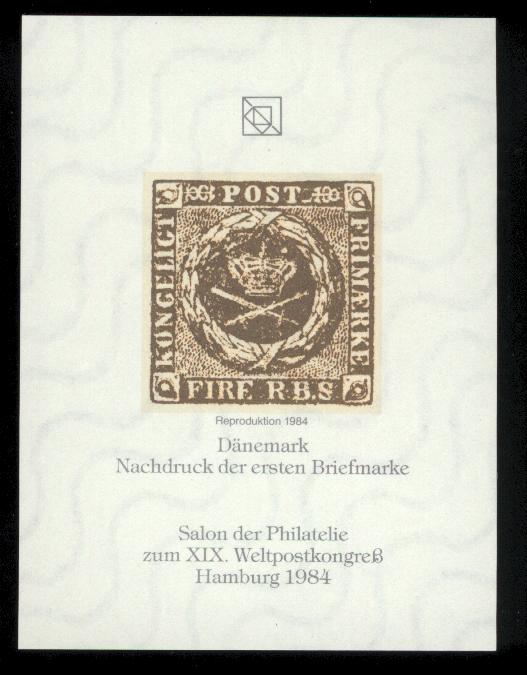
Modern reproduction for the Salon der Philatelie in Hamburg in
1984.

Reprints made in 1951 for the International Frimaerke Udstilling
in Kopenhagen.
2 s blue 3 s lilac 4 s red 8 s brown 16 s olive
These stamps are perforated 13, 13 x 12 1/2, 13 1/2 x 13 or 12 1/2.
Value of the stamps |
|||
vc = very common c = common * = not so common ** = uncommon |
*** = very uncommon R = rare RR = very rare RRR = extremely rare |
||
| Value | Unused | Used | Remarks |
| 2 s | *** | ** | |
| 3 s | *** | *** | |
| 4 s | *** | c | |
| 8 s | RR | *** | |
| 16 s | RR | *** | |
Imperforate 4 s stamps were sold at the post office at some stage. Other imperforate stamps are from remainders (brought in 1912 onto the market). Also, perforated stamps with their perforation cut off exist.
Reprints exist of all values, made in 1886 (no watermark and imperforate). If anybody posesses information about these reprints, please contact me!
Typical cancel, three rings:
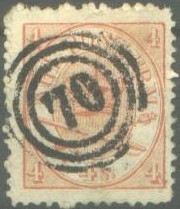
I have seen postal stationary in the same design (16 s olive).
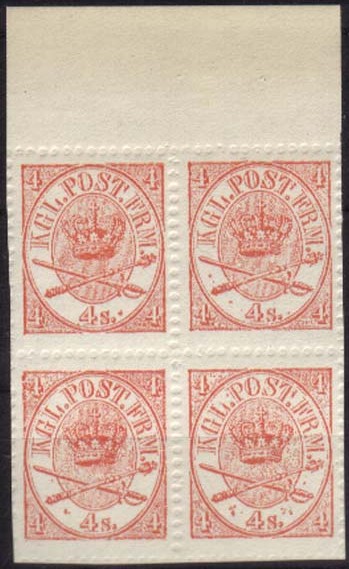

Some reprints 'NYTRYK' of the 4 s value made for the 'Hafnia 76'
Value in Sk(illing)
2 s grey and blue 3 s grey and lilac 4 s grey and red 8 s grey and brown 16 s grey and green 48 s brown and lilac
Reprints exist of all values. If anybody posesses information about these reprints, please contact me!
Value of the stamps |
|||
vc = very common c = common * = not so common ** = uncommon |
*** = very uncommon R = rare RR = very rare RRR = extremely rare |
||
| Value | Unused | Used | Remarks |
| 2 s | * | * | |
| 3 s | *** | *** | |
| 4 s | *** | c | |
| 8 s | *** | *** | |
| 16 s | *** | *** | |
| 48 s | RR | R | |
Value in Ore (1875)
3 o blue and grey 4 o grey and blue 5 o red and blue 8 o grey and red 12 o grey and red 16 o grey and brown 20 o red and grey 25 o grey and green 50 o brown and lilac 100 o grey and yellow
These stamps have perforation 14 x 13 1/2 or 12 1/2.
Value of the stamps |
|||
vc = very common c = common * = not so common ** = uncommon |
*** = very uncommon R = rare RR = very rare RRR = extremely rare |
||
| Value | Unused | Used | Remarks |
| 3 o | c | c | |
| 4 o | c | vc | |
| 5 o | ** | ** | 1879 |
| 8 o | c | vc | |
| 12 o | * | vc | |
| 16 o | * | c | |
| 20 o | *** | * | |
| 25 o | * | c | |
| 50 o | * | c | |
| 100 o | * | c | |
Surcharged
'4 ORE' on 8 o grey and red (1904) '35 ORE' (blue) on 16 o grey and brown (1912) '35 ORE' (blue) on 20 o red and grey (1912) '80 ORE' on 12 o grey and red (1915)
Value of the stamps |
|||
vc = very common c = common * = not so common ** = uncommon |
*** = very uncommon R = rare RR = very rare RRR = extremely rare |
||
| Value | Unused | Used | Remarks |
| 4 o on 8 o | c | c | |
| 35 o on 16 o | * | * | |
| 35 o on 20 o | * | * | |
| 80 o on 12 o | *** | *** | |
Typical cancels:
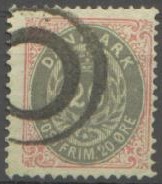
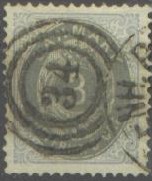
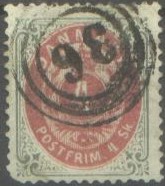
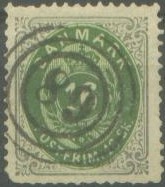
Postcards in the same design:
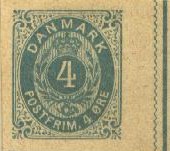
(Reduced size)
I have seen the values (all printed in one colour only!) 2 sk blue, 4 sk red, 3 o grey, 4 o blue, 6 o brown, 8 o red and 10 o green. Also a 4 o blue with a black circular '5' overprint and a small '5' on the small '4'.
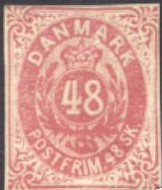
What is this? 48 sk red, cut from an envelope or bogus issue?
All these stamps have a watermark 'crown':
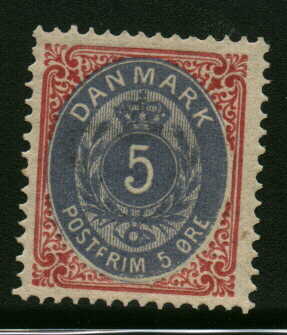
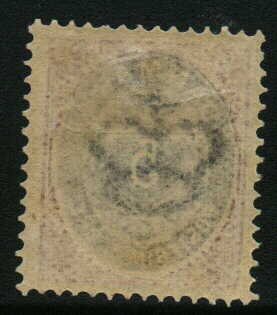


Imperforate reprint of the 100 a value from 1977.
For stamps of Denmark from 1882 to 1920, click here.
Forfalskning = forgery